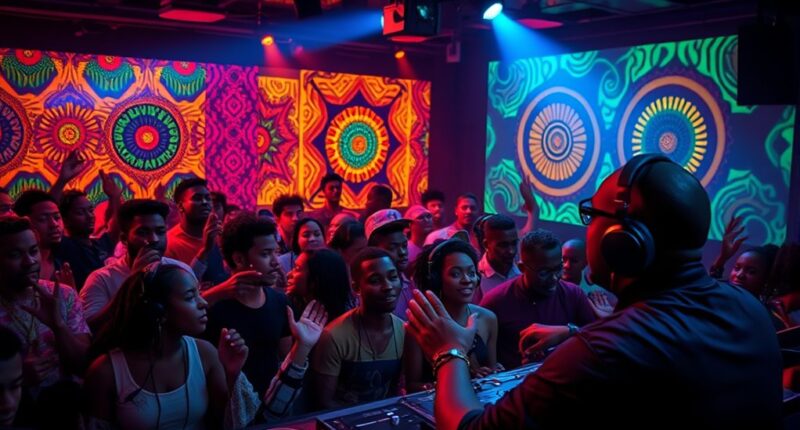You’ll find that the roots of call-and-response in modern club hits trace back to African and Indigenous musical traditions, where it’s used for communication and community bonding. These techniques evolved through gospel and blues, emphasizing participation and emotional connection. Today, producers incorporate traditional patterns with modern beats, creating energetic and unifying rhythms on the dance floor. If you keep exploring, you’ll discover how these age-old traditions continue to shape contemporary dance music’s vibrant spirit.
Key Takeaways
- Call-and-response originates from African, Indigenous, and Caribbean traditions, serving as a communal communication and storytelling tool.
- It evolved into gospel and blues, using musical dialogue to foster spiritual connection and personal expression.
- Modern club hits incorporate sampling and lyrical call-outs, preserving traditional patterns within electronic and dance music styles.
- The technique promotes community building and shared identity on the dance floor, enhancing collective participation.
- DJs and producers utilize call-and-response to energize audiences, linking cultural roots with contemporary musical engagement.
Origins of Call-and-Response in African Musical Traditions
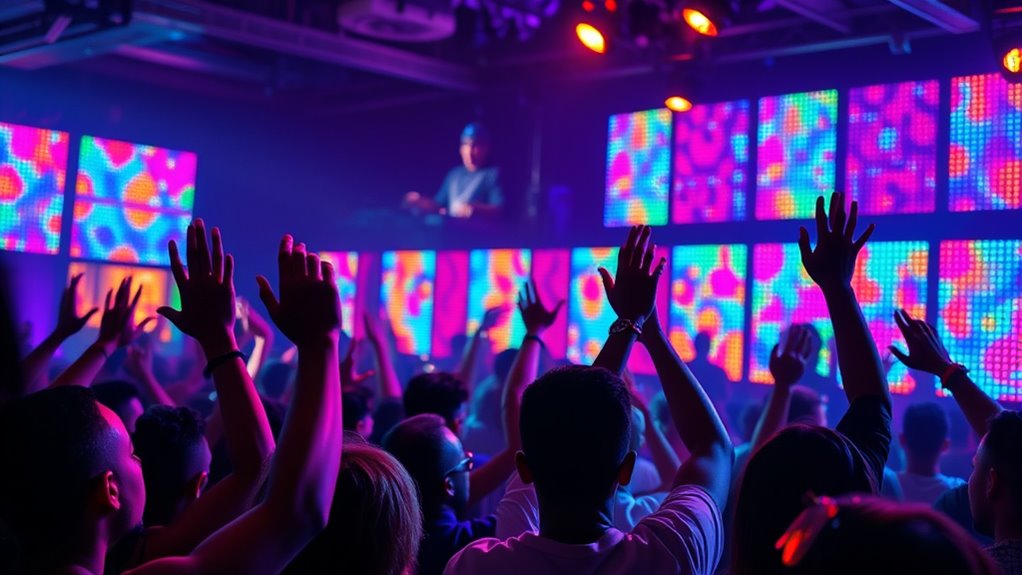
African musical traditions have long used call-and-response as a fundamental structure, reflecting communal participation and storytelling. You’ll notice that rhythmic communication is central to these traditions, allowing performers and audiences to engage actively. Participatory singing encourages everyone to take part, creating a shared experience that strengthens community bonds. This musical style isn’t just about melody; it’s about interaction and connection. When a lead singer or instrumentalist delivers a call, others respond, maintaining the rhythm and energy. This back-and-forth fosters a sense of unity and collective expression. The origins of call-and-response are rooted in these communal practices, where music becomes a form of dialogue. It’s a powerful way to transmit stories, history, and cultural values across generations. Additionally, the dynamic nature of these interactions helps to keep musical traditions alive and adaptable in diverse modern contexts.
The Role of Call-and-Response in African-American Cultural Expression
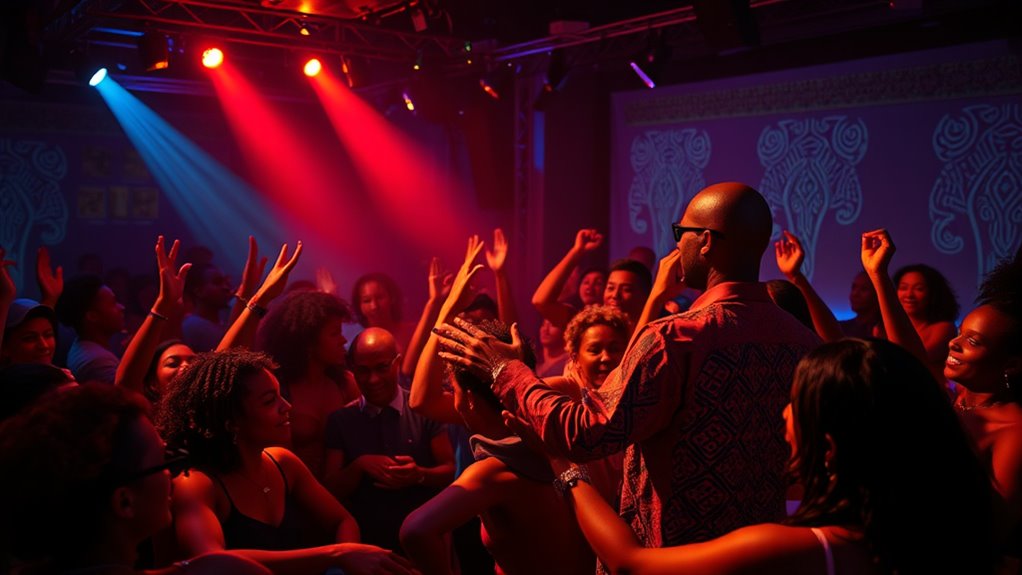
Call-and-response has become a powerful tool for expressing identity, resilience, and community in African-American cultural practices. It maintains cultural continuity, connecting past struggles with present expressions of strength. This dynamic exchange helps reinforce musical identity and fosters a sense of belonging. When you hear call-and-response, you feel:
- The unbreakable bond across generations
- The collective voice sharing stories of triumph and hardship
- A deep-rooted pride that sustains cultural memory
Through this interaction, you participate in a tradition that celebrates resilience and unity. It’s more than music; it’s an essential expression of shared history and ongoing cultural vibrancy. Call-and-response keeps the spirit alive, ensuring the legacy continues in every beat and chorus. Understanding its historical evolution enriches appreciation of its significance in contemporary culture.
Evolution of Call-and-Response in Gospel and Blues Music
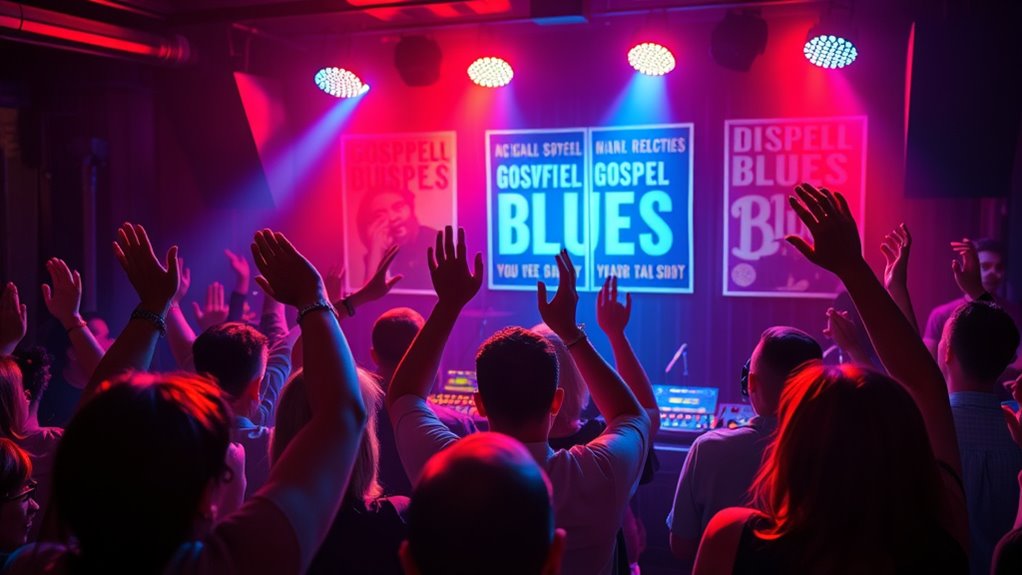
You’ll see how call-and-response evolved from its roots in gospel to become a key feature of blues music. In gospel, it often reflects spiritual dialogue, while blues uses it as an expressive musical conversation. This transformation highlights how these genres shaped each other and maintained their cultural significance. Additionally, the musical conversation aspect emphasizes the role of improvisation and emotional expression in both styles.
Call-and-Response Origins in Gospel
The evolution of call-and-response in gospel music reflects a deep cultural tradition that has shaped its expressive power. This technique connects singers and listeners, creating a shared spiritual experience. You can trace its roots to African musical practices, where call and response in folk music fostered community bonds. Gospel singers adapted these patterns, blending them with call and response in jazz to add improvisation and emotion. This tradition also echoes in spirituals, reinforcing collective faith and resilience. The call-and-response style energizes worship, inspiring participation and unity. It’s a powerful form that transcends music, embodying cultural resilience, spiritual connection, and communal strength. Through gospel, call-and-response becomes a voice of collective hope and perseverance, echoing in modern musical expressions. Additionally, the interactive nature of call-and-response encourages active engagement from audiences, making performances more dynamic and communal.
Blues as Musical Dialogue
As the blues developed from African-American musical traditions, they embraced call-and-response as a fundamental way for artists to engage their audience and express emotion. You’ll notice that blues musicians often use musical improvisation, allowing performers to spontaneously respond to their own phrases or to audience cues. This creates a dynamic dialogue where the musician’s voice invites audience participation, making each performance unique. The call-and-response structure fosters an intimate connection, encouraging listeners to become part of the musical conversation. Over time, this interaction evolved into a form of musical dialogue that emphasizes personal expression and communal involvement. By blending improvisation with audience engagement, the blues solidified its role as a powerful form of cultural storytelling rooted in shared musical communication. Additionally, the emphasis on emotional intelligence in performance helps deepen the connection between artists and audiences, creating a lasting impact.
Transition of Call-And-Response Into Contemporary Dance Music
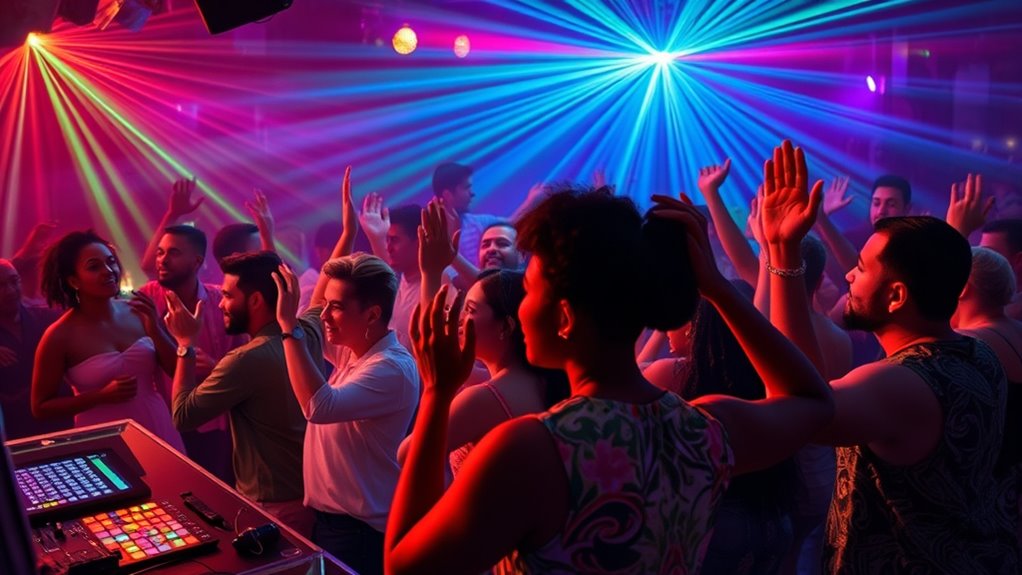
The vibrant call-and-response tradition has seamlessly evolved into the structure of contemporary dance music, providing a rhythmic and participatory foundation that energizes modern tracks. This shift highlights the powerful Cultural Influence that keeps these patterns alive, adapting them for new audiences. The rhythmic interaction between vocal snippets and beats creates an infectious energy, encouraging crowd participation and connection. You feel this in the way DJs build anticipation with call-and-response cues, making you part of the experience. It’s a dynamic cycle that drives the dance floor forward. This evolution also demonstrates how traditional musical forms can be preserved and transformed through music training methods, ensuring their relevance in today’s musical landscape.
Producers and Artists Incorporating Traditional Techniques in Modern Tracks
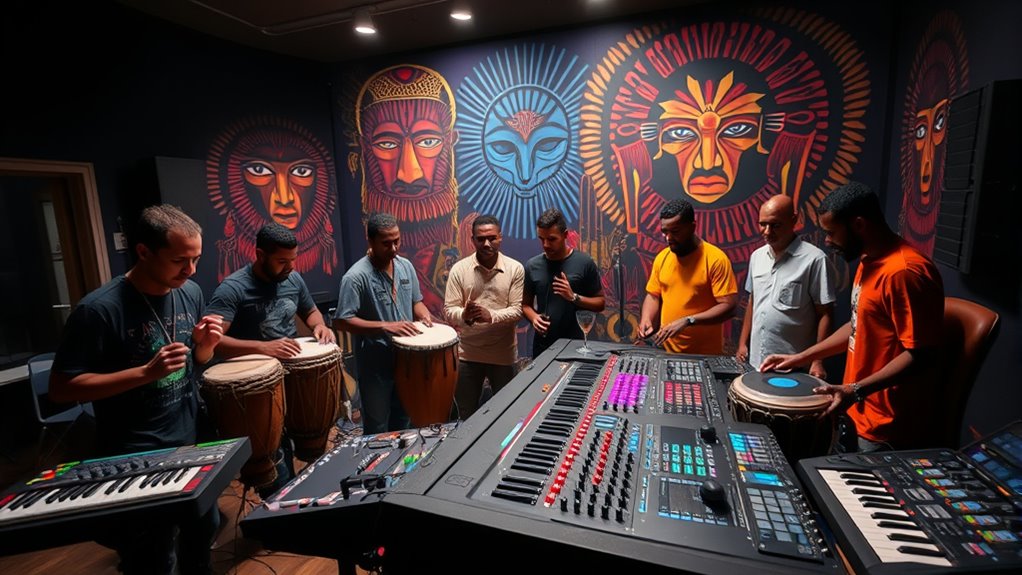
Producers and artists today actively incorporate traditional call-and-response techniques into their modern tracks, creating a bridge between cultural heritage and contemporary music. They often use sampling techniques to embed authentic vocal snippets or instrumental motifs that evoke traditional styles. Lyrical call outs are strategically placed within songs to engage listeners and emulate the conversational dynamic of traditional call-and-response. By blending these elements with electronic beats and modern production, artists preserve cultural significance while appealing to new audiences. This approach not only honors ancestral practices but also demonstrates how cultural roots can evolve within current music trends. Additionally, understanding the cultural significance of these techniques helps explain their enduring relevance and emotional impact. As a result, you experience a seamless fusion of history and innovation, where traditional call-and-response techniques remain essential and relevant in today’s musical landscape.
The Enduring Power of Call-and-Response on the Dance Floor

Call-and-response remains a powerful force on the dance floor because it encourages active participation and creates a shared energy among listeners. When you respond to a vocalist’s call, you become part of the music’s rhythm, fueling the collective experience. This interaction sparks emotion, igniting feelings of unity and excitement. Audience participation through call-and-response makes every dance session memorable. Vocal improvisation adds spontaneity, allowing you to connect more deeply with the music. It’s about feeling the moment and contributing your voice. The energy builds as everyone engages, creating an atmosphere that’s alive and inclusive. Enhancing community through these musical exchanges fosters a sense of belonging and shared purpose on the dance floor.
Frequently Asked Questions
How Does Call-And-Response Influence Audience Participation in Modern Club Settings?
Call-and-response boosts audience engagement by encouraging rhythmic participation in modern club settings. When you respond to a DJ’s cues or lyrics, you become part of the performance, making the experience more immersive. This interaction heightens excitement, energizes the crowd, and fosters a sense of community. Your active participation not only enhances the atmosphere but also keeps the momentum going, creating a memorable, collective musical experience that keeps everyone involved.
Are There Specific Cultural Communities More Associated With Call-And-Response Traditions Today?
You might notice that call-and-response still thrives in diverse cultural communities, from African American and Latinx groups to Caribbean and Indigenous traditions. While it’s deeply rooted in specific cultural identities, it also fosters community engagement worldwide. This dynamic interaction bridges cultural divides, celebrating shared experiences and reinforcing social bonds. In modern clubs, these traditions adapt, creating vibrant spaces where cultural identity and community engagement blend seamlessly through energetic exchanges.
What Are the Technological Tools Used to Incorporate Traditional Call-And-Response Elements Into Modern Music?
You use various technological tools to incorporate traditional call-and-response elements into modern music. Sampling techniques allow you to digitally capture and reuse authentic call-and-response phrases, giving your track cultural depth. Digital effects like echo, reverb, and delay enhance these interactions, making them more engaging. These tools help you blend traditional sounds with contemporary production, creating dynamic, culturally rich music that resonates with diverse audiences.
How Do Contemporary Producers Adapt Call-And-Response for Digital and Streaming Platforms?
Imagine you’re crafting a conversation across a digital canyon—this is how you adapt call-and-response today. Using sampling techniques, you capture classic vocal exchanges and weave them into new tracks. Vocal manipulation tools let you twist voices, making responses sound fresh and engaging. On streaming platforms, you’re effectively echoing voices across vast virtual spaces, keeping the spirit alive while customizing responses to resonate with modern audiences.
Can Call-And-Response Techniques Be Integrated Into Non-Musical Forms of Entertainment?
You can definitely integrate call-and-response techniques into non-musical entertainment like interactive storytelling and visual arts. In storytelling, audience participation creates a dynamic exchange, much like call-and-response, encouraging engagement. In visual arts, interactive exhibits invite viewers to respond or contribute, fostering an active dialogue. These methods leverage the core principle of response and participation, making experiences more immersive and memorable beyond traditional music settings.
Conclusion
You can feel the heartbeat of history pulsing through modern club hits, like a timeless echo that refuses to fade. Call-and-response isn’t just a musical technique; it’s the bridge that connects ancient traditions to today’s dance floors. When you move to these beats, you’re part of a story that’s been sung and shouted across generations. It’s a living legacy, shaping the rhythm of the night and reminding us that music’s roots are never really buried—it’s just waiting to rise again.
